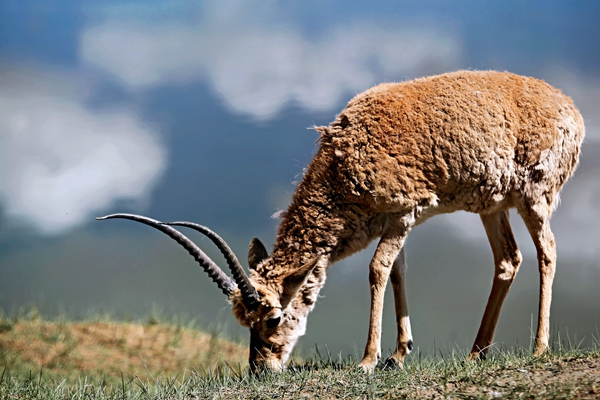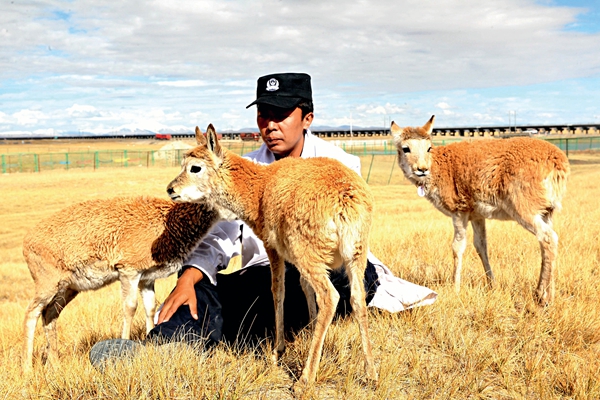The Tibetan antelope
- By Jane Lu
 0 Comment(s)
0 Comment(s) Print
Print E-mail China Today, January 10, 2018
E-mail China Today, January 10, 2018
Editor's note: Due to its broad territory and diverse natural environment, China is home to the widest range of wildlife species with 6,266 kinds of vertebrates, including 2,404 kinds of terrestrial animals and 3,862 kinds of fish, which make up nearly 10 percent of the world's vertebrates. The giant panda, the snub-nosed monkey, the South China tiger, the brown-eared pheasant, the red-crowned crane, the crested ibis, the white-flag dolphin, and the Chinese alligator are some of China's rare species of wild animals. This year, we have created a column to introduce some of these animals.

The Tibetan antelope inhabits the harsh steppe areas at an elevation of 4,000 to 6,000 km, and is under China's highest level of protection. The government has established three national nature reserves in Tibet, Qinghai, and Xinjiang. The locations are around the Kunlun Mountains and Altun Mountain in Western China, among which Hoh Xil in Qinghai Province is the best known.
The lifespan of a Tibetan antelope is about eight years on average. A mother antelope, around two years of age, usually breeds for the first time and a single cub is born. Mating occurs in November and December. The gestation lasts for seven to eight months. Every summer pregnant females travel along fixed routes to Hoh Xil to give birth, where grass and water are plenty while natural enemies are few, especially around the Drone Lake and Taiyang Lake. The rich variety of food and relatively safe environment are favorable for breeding and raising baby antelopes. Soon afterwards, the females make the return journey together with their babies. It was not a few years ago that grand scenes of mass migration of about 2,000 Tibetan antelopes could be seen.
The Tibetan antelope is timid by nature, and can run at a speed of 80 km per hour. Male antelopes are also called unicorns in China, as their symmetrical angles look like a single horn from afar. They have developed thick underfur for the harsh climate.
There used to be millions of Tibetan antelopes according to historical records, but the population had plummeted since the 1990s and dropped to about 50,000 to 75,000 in the mid-1990s. People could only see scattered antelopes in the previously densely populated areas. Therefore, it was listed among the first-class protected species under the National Wildlife Protection Law. Hunting and trade are strictly forbidden. In 2008, it was listed as an endangered species on the Red List of Threatened Species by the International Union for the Conservation of Nature and Natural Resources (IUCN).
One reason to account for this is the more occurrences of extreme weather. The antelopes, especially females and the young, are susceptible to death in the freezing cold weather.

Another cause is human encroachment on their habitats. The reclamation of uninhabited areas led to a reduced area for antelopes' habitation. For instance, rare animals such as kiangs and Tibetan antelopes used to live in the uninhabited area – Shuanghu County on the northern Changtang Plateau. Since the mid-1970s, however, people came and turned it into pastures, disrupting hundreds of square kilometers of the ecological environment. Another example is the Ulan Ula Lake and Taiyang Lake in western Qinghai Province. After the discovery of gold mines, people flocked in and destroyed the primeval vegetation, making it increasingly difficult for Tibetan antelopes to survive.
However, the ultimate reason for the drastic decline of antelope population is human greed. Poachers rampantly kill the animals for hides, as the exceptionally fine and soft underfur can be woven into a luxury shawl – Shahtoosh. Illegal poachers usually smuggle the fur, called “soft gold,” to Nepal and India and finally to countries such as Italy and France. In addition, the pitch-black antlers of male antelopes are regarded a rare medical material, and the heads used to be a kind of fancy decorations, thus making antelopes a target for illegal hunters and smugglers. In May 2003, the police cracked a big case of armed poachers who killed more than 1,000 antelopes. According to incomplete statistics, about 20,000 antelopes were poached from 1980 to 2005. The life of antelopes was disturbed and breeding affected because of poaching.
In this connection, the Chinese government set up nature reserves, cracked down on poaching, and sought international cooperation in banning illegal trade of antelope fur products. In 1999, an international symposium on antelope protection and trade controls was held in Xining, capital of Qinghai Province. Representatives from seven countries including China, France, India, Italy, Nepal, and the U.K. reached consensus and issued The Xining Declaration.
In addition, numerous volunteers have participated in protection efforts by saving injured young antelopes, prohibiting illegal earth and sand digging, and raising people's awareness of environmental protection. During migration season, staff and volunteers could be seen regularly near the Qinghai-Tibet Highway, stopping vehicles to allow the antelopes to cross. When the Qinghai-Tibet Railway was under construction, antelopes' migration was given special attention. Thirty-three special passageways – with a width of one to two km – were built along the migration routes in Changtang Plateau and Hoh Xil. Thanks to years of anti-poaching efforts, the antelope population in Tibet has grown to 170, 000 at the end of 2012.
Jane Lu is a freelance writer in Beijing.






Go to Forum >>0 Comment(s)